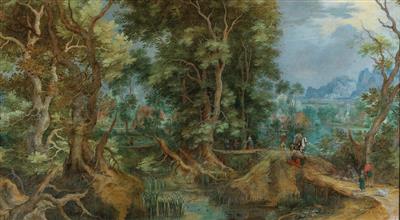Gillis van Coninxloo II

(Antwerp 1544–1607 Amsterdam)
An extensive wooded landscape with a village and a town by the mountains beyond,
signed with monogram and dated 1602 lower right,
oil on canvas, 86 x 153 cm, framed
Gillis van Coninxloo II was one of the most important Flemish landscape painters active in the last quarter of the sixteenth century. With his forest landscapes he contributed substantially to the development of landscape as a genre in its own right, influencing such painters as Jan Brueghel the Elder, Pieter Schoubroeck and David Vinckboons. That he was held in high esteem by his contemporaries - first in Flanders and subsequently also in Holland - is attested to by Karel van Mander’s biography of the artist, which already appeared in Coninxloo’s lifetime (Het schilder-boeck, Haarlem 1604, fol. 268r). Karel van Mander knew Coninxloo personally and sometimes executed the figures in his landscapes: ‘Currently I do not know a better landscapist, and I can see how his approach starts being widely imitated in Holland; and the trees […] have begun growing in the manner of his as well as they can.’ Whereas in his early work Coninxloo resorted to vast panorama landscapes, towards the late sixteenth century he developed a type of forest landscape viewed from close up in which figures only played a subordinate role.
The present large-size painting is an important example of Coninxloo’s later landscapes. The Historisches Museum der Pfalz (Speyer, inv. no. HM 1957/122) has a comparable forest landscape by the artist. Gillis van Coninxloo II was born in Antwerp in 1544 son to the painter Jan van Coninxloo II. He spent the years of his apprenticeship with Pieter Coecke van Aelst and Gillis Mostaert. After a short study trip to France he returned to Antwerp and was admitted to the local Guild of Saint Luke in 1570. When the Spaniards besieged the town on the River Scheldt in 1585, the Calvinist escaped to Zeeland and, two years later, to Frankenthal near Hanau in the Palatinate. There he became one of the most influential members of the Frankenthal school of painters, other exponents of which were Anton Mirou and Pieter Schoubroeck. In 1595 Coninxloo moved to Amsterdam. He became a naturalised citizen and member of the chamber of rhetoricians ‘Twit Lavendel’. He died there in early 1607.
Esperto: Dr. Alexander Strasoldo
 Dr. Alexander Strasoldo
Dr. Alexander Strasoldo
+43 1 515 60 403
oldmasters@dorotheum.com
22.10.2019 - 18:30
- Prezzo realizzato: **
-
EUR 27.592,-
- Stima:
-
EUR 15.000,- a EUR 20.000,-
Gillis van Coninxloo II
(Antwerp 1544–1607 Amsterdam)
An extensive wooded landscape with a village and a town by the mountains beyond,
signed with monogram and dated 1602 lower right,
oil on canvas, 86 x 153 cm, framed
Gillis van Coninxloo II was one of the most important Flemish landscape painters active in the last quarter of the sixteenth century. With his forest landscapes he contributed substantially to the development of landscape as a genre in its own right, influencing such painters as Jan Brueghel the Elder, Pieter Schoubroeck and David Vinckboons. That he was held in high esteem by his contemporaries - first in Flanders and subsequently also in Holland - is attested to by Karel van Mander’s biography of the artist, which already appeared in Coninxloo’s lifetime (Het schilder-boeck, Haarlem 1604, fol. 268r). Karel van Mander knew Coninxloo personally and sometimes executed the figures in his landscapes: ‘Currently I do not know a better landscapist, and I can see how his approach starts being widely imitated in Holland; and the trees […] have begun growing in the manner of his as well as they can.’ Whereas in his early work Coninxloo resorted to vast panorama landscapes, towards the late sixteenth century he developed a type of forest landscape viewed from close up in which figures only played a subordinate role.
The present large-size painting is an important example of Coninxloo’s later landscapes. The Historisches Museum der Pfalz (Speyer, inv. no. HM 1957/122) has a comparable forest landscape by the artist. Gillis van Coninxloo II was born in Antwerp in 1544 son to the painter Jan van Coninxloo II. He spent the years of his apprenticeship with Pieter Coecke van Aelst and Gillis Mostaert. After a short study trip to France he returned to Antwerp and was admitted to the local Guild of Saint Luke in 1570. When the Spaniards besieged the town on the River Scheldt in 1585, the Calvinist escaped to Zeeland and, two years later, to Frankenthal near Hanau in the Palatinate. There he became one of the most influential members of the Frankenthal school of painters, other exponents of which were Anton Mirou and Pieter Schoubroeck. In 1595 Coninxloo moved to Amsterdam. He became a naturalised citizen and member of the chamber of rhetoricians ‘Twit Lavendel’. He died there in early 1607.
Esperto: Dr. Alexander Strasoldo
 Dr. Alexander Strasoldo
Dr. Alexander Strasoldo
+43 1 515 60 403
oldmasters@dorotheum.com
|
Hotline dell'acquirente
lun-ven: 10.00 - 17.00
old.masters@dorotheum.at +43 1 515 60 403 |
| Asta: | Dipinti antichi II |
| Tipo d'asta: | Asta in sala |
| Data: | 22.10.2019 - 18:30 |
| Luogo dell'asta: | Wien | Palais Dorotheum |
| Esposizione: | 12.10. - 22.10.2019 |
** Prezzo d'acquisto comprensivo di tassa di vendita e IVA(Paese di consegna Austria)
Non è più possibile effettuare un ordine di acquisto su Internet. L'asta è in preparazione o è già stata eseguita.
